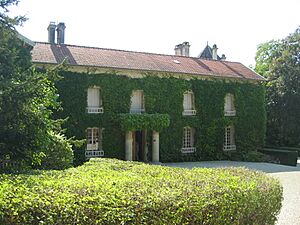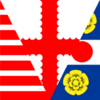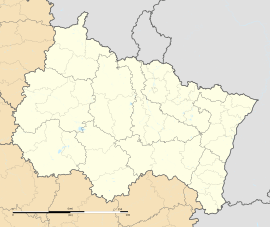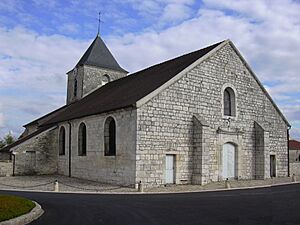Colombey-les-Deux-Églises facts for kids
Quick facts for kids
Colombey-les-Deux-Églises
|
|||
|---|---|---|---|

Charles de Gaulle Monument
|
|||
|
|||
| Country | France | ||
| Region | Grand Est | ||
| Department | Haute-Marne | ||
| Arrondissement | Chaumont | ||
| Canton | Châteauvillain | ||
| Intercommunality | CA Chaumont | ||
| Area
1
|
83.84 km2 (32.37 sq mi) | ||
| Population
(2021)
|
679 | ||
| • Density | 8.099/km2 (20.976/sq mi) | ||
| Time zone | UTC+01:00 (CET) | ||
| • Summer (DST) | UTC+02:00 (CEST) | ||
| INSEE/Postal code |
52140 /52330
|
||
| 1 French Land Register data, which excludes lakes, ponds, glaciers > 1 km2 (0.386 sq mi or 247 acres) and river estuaries. | |||
Colombey-les-Deux-Églises (French pronunciation: [kɔlɔ̃bɛ le dø.z‿eɡliz]) is a commune in the Haute-Marne department in north-eastern France. It is best known as the home of Charles de Gaulle.
The municipality of Colombey-les-Deux-Églises was created administratively in 1793, and it became part of the district of Chaumont and the canton of Blaise. In 1801, under the name Colombey, it passed to the canton Juzennecourt. In January 1973, it absorbed the communes Argentolles, Biernes, Blaise, Champcourt, Harricourt, Pratz and Lavilleneuve-aux-Fresnes. On 1 January 2017, the former commune of Lamothe-en-Blaisy was merged into Colombey-les-Deux-Églises.
Colombey's name means "cemetery", from the Latin colombarium. The "two churches" referenced in the name are the parish church, Notre-Dame-en-son-Assomption, and the pre-revolutionary Cluniac priory of Saint-Jean-Baptiste.
Contents
Charles de Gaulle

Colombey achieved fame as the home and burial site of the 20th-century soldier and statesman Charles de Gaulle, who acquired a substantial property on the southwestern edge of the village in 1934. De Gaulle withdrew repeatedly to Colombey when his political fortunes waned, first on the establishment of the Fourth Republic in 1946, and then between 1953 and 1958, before he became president again at the height of the Algerian Crisis. His final withdrawal to Colombey came in 1969 and he died there the following year. "Colombey" became widely used as a political metaphor for a statesman's temporary withdrawal from political life until his country came calling for him again.
De Gaulle is buried in the cemetery in Colombey, in a humble grave with the inscription "Charles de Gaulle 1890-1970". In addition, a 145 ft (44.3 m) high Cross of Lorraine was built at the western exit of the village, commemorating his distinguished wartime role as commander of the Free French Forces. A memorial museum was inaugurated in October 2008 by Nicolas Sarkozy and Angela Merkel. This joint Franco-German act marked the fiftieth anniversary of talks in Colombey on 14 September 1958 between Charles de Gaulle and Konrad Adenauer, as part of the process of post-war reconciliation.
Geography
The River Blaise flows through the commune.
History
On September 14, 1958, Charles de Gaulle received Federal Chancellor Konrad Adenauer on a private visit to La Boisserie.
See also
 In Spanish: Colombey les Deux Églises para niños
In Spanish: Colombey les Deux Églises para niños






